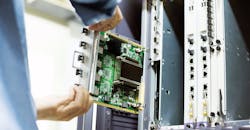Intel, the world's top chip manufacturer, reported stronger-than-anticipated sales and profits in the third quarter ending in September, buoyed by a rebound in demand for processors used in data centers and cloud servers, despite mounting competition and an ongoing shortages of chips. The company’s earnings also eased concerns around the Trump administration’s trade war with China, which has been a thorn in the semiconductor industry’s side in 2019.
The Santa Clara, California-based company said sales in the third quarter surged $19.2 billion, after warning about tough times ahead when the company reported second-quarter earnings in July. Intel had forecast stimated sales of $18 billion in the third quarter. Intel, which has been fighting shortages of chips amid sagging demand in its personal computer and data center markets, said profit was $1.35 a share, compared with the company’s $1.16-a-share forecast.
The results come as the trade war with China cast a pall over the U.S. semiconductor industry. Texas Instruments, often seen as a bellwether for the segment because of its broad base of customers and vast assortment of products, said trade tensions are making many of its customers more cautious. Broadcom, slammed by trade tensions and harsh restrictions on supplying chips to Huawei Technologies, has slashed about $2 billion from its 2019 guidance.
Intel has not been as hard hit by the trade tensions and unstable global economy. Intel has been skyrocketing in recent years as big cloud computing firms ranging from Microsoft, Google and Amazon in the United States to Alibaba, Tencent and Baidu in China have burned through billions of dollars to build out data centers that they rent out to other businesses. But the company's strong growth has slumped as global spending on cloud infrastrcuture has cooled off.
Customers started to curb spending in the second half of 2018 to give themselves time to get through all the inventory they amassed in the first half of 2018. The Trump administration's trade war with China, in which both sides have slapped steep tariffs on each other's products, has also throttled spending from Intel's major cloud customers in China. Intel recovered in the third quarter as a long pause in capital spending on giant data centers finally started to thaw.
Sales of the company's server chips over the last quarter totaled $6.4 billion, up from $6.1 billion in the third quarter of 2018 and up from $5 billion in the second quarter of 2019. Even though shipments declined 6% in its last quarter, customers are buying more of the most advanced SKUs in its latest line of Xeon Scalable processors, code named Cascade Lake, which raised average selling prices by 9%. Server chips today tend to cost thousands of dollars each.
“Our experience with cloud providers is they go through big buying cycles and then relatively long digestion periods. What we experienced last year was a gangbuster year,“ Bob Swan, Intel’s CEO, said on a conference call with analysts, adding that customers have been digesting inventory for the last three quarters. “In the third quarter, particularly for high performance compute, [we] started to see them come back to the market to begin to purchase a little more.”
Intel forecast fourth-quarter sales of around $19.2 billion, up 3% year-over-year, driven by the rebound in demand for chips powering cloud infrastructure and improving prices for flash memory. The company also estimated adjusted earnings of $1.24 per share. George Davis, Intel's chief financial officer, said that it had also added $1.5 billion to its full-year sales forecast, bringing the estimated total to $71 billion in 2019, up slightly from $70.8 billion in 2018.
Shares of the Silicon Valley company have added more than 8% following the forecast. The company’s shares have lagged behind other major players in the global semiconductor industry over the last year, rising roughly 19% in 2019. Shares of rival Advanced Micro Devices have surged more than 90% in 2019, while Qualcomm has moved up more than 40%. Micron Technology, which has been hammered by tough trade sanctions against Huawei, is up 45%.
Intel's shares have struggled in recent months as the company faces a range of challenges, including weaker underlying demand in data centers. Delays in the development of its 10-nanometer node have continued to loom over the world's largest chip maker. Last year, Intel surrendered its lead in advanced chip production to TSMC, which has started supplying chips to AMD for data centers and personal computers based on a more advanced 7-nanometer node.
Intel is facing competition from Santa Clara, California-based AMD for the first time in more than a decade. AMD is pushing its updated lineup of Ryzen CPUs and EPYC CPUs to challenge Intel's Core CPUs—which dominate the high-end market for personal computers—and Xeon CPUs—which holds more than 95% of the global market share in data centers. AMD is also gaining ground on Intel the mid-range and low-end markets for desktops and laptops.
AMD is also taking aim at Intel's stronghold in data centers. AMD has added most of the major players in the cloud computing industry, including Microsoft, Google and Amazon in the U.S., as well as some of their Chinese counterparts to its customer list. Industry analysts estimate AMD could steal up to 10% of the market with its new line of EPYC CPUs. The second-generation server chips feature up to 64 cores based on TSMC's 7-nanometer process.
"It's a more competitive world and we feel really good about where we are," Swan said on the conference call with analysts last week. He said that the company's latest line of server chips, called Cascade Lake, has been winning business ahead of the launch of its Cooper Lake processors in the first half of 2020. Intel also reiterated its plans to roll out its 10-nanometer Xeon Scalable processors, code named Ice Lake, in the second half of 2020 to customers.
"We've got a great lineup of products," Swan said. "But we're not complacent by any means."
Intel has also slashed the price of its latest Core-X processors for high-end gaming computers by up to 50%, in what industry analysts called an attempt to turn the tables on AMD. The company has also started selling its first generation of chips based on the 10-nanometer node for use in 30 laptops and other mobile PC platforms to be released by the end of the year. "The 10-nanometer era is now," Swan said. "We're ramping a multitude of products."
Intel is also looking to reclaim the throne in advanced chip technology from TSMC, which over the last year has cemented its critical role in the electronics market. Intel plans to start selling a new generation of chips based on the 7-nanometer node by the end of 2021, and it is also "well down the engineering path" for its 5-nanometer node, which could come out in 2023 or 2024. "We're investing to recapture process leadership going forward," Swan told analysts.
The company reported that third-quarter profit dropped 6% to $6 billion, or $1.35 per share, from $6.4 billion, or $1.38 a share, over the same period last year. Gross margins—the selling price of its products minus the cost of production—slipped from 64.5% to 58.9% over the last year as shipments declines and higher production costs more than offset higher average selling prices and lower spending on struggling businesses, such as memory chips and modems.
Intel’s personal computer business slumped 5% to $9.7 billion as it struggled to meet the demand for core processors used in laptops and desktops. The company hopes to resolve the shortage, which started more than a year ago and has eroded its market share, before the end of 2020. Global shipments of PCs totaled 68 million units in the third quarter, up slightly more than 1% from the same time last year, according to market research firm Gartner.
The company’s memory chip business, which has long struggled to make money, improved 19% in the third quarter amid strong demand for NAND flash and Optane memory even though the global supply of flash memory continues to surpass demand, leading to lower selling prices. Internet of Things sales surged 9% to more than $1 billion. Intel's Mobileye autonomous driving business jumped 20% to nearly $230 million in sales in the third quarter of 2019.
About the Author
James Morra
Senior Editor
James Morra is the senior editor for Electronic Design, covering the semiconductor industry and new technology trends, with a focus on power electronics and power management. He also reports on the business behind electrical engineering, including the electronics supply chain. He joined Electronic Design in 2015 and is based in Chicago, Illinois.

